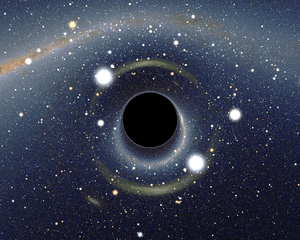Kugelblitz (astrophysics)
In theoretical physics, a kugelblitz (German: "ball lightning") is a concentration of light so intense that it forms an event horizon and becomes self-trapped: according to general relativity, if enough radiation is aimed into a region, the concentration of energy can warp spacetime enough for the region to become a black hole (although this would be a black hole whose original mass-energy had been in the form of radiant energy rather than matter). In simpler terms, a kugelblitz is a black hole formed from radiation as opposed to matter. According to Einstein's general theory of relativity, once an event horizon has formed, the type of energy that created it no longer matters. A kugelblitz is so hot it surpasses the Planck temperature, the temperature of the universe 5.4×10−44 seconds after The Big Bang.
The best-known reference to the kugelblitz idea in English is probably John Archibald Wheeler's 1955 paper "Geons",[1] which explored the idea of creating particles (or toy models of particles) from spacetime curvature. Wheeler's paper on geons also introduced the idea that lines of electric charge trapped in a wormhole throat might be used to model the properties of a charged particle-pair.
Kugelblitz drives are considered as possible future spaceship engines.[2]
In fiction
- In the Star Trek Universe, the Romulan D'deridex class uses an artificial quantum singularity Kugelblitz as power source/propulsion.
- A kugelblitz is an important plot element in Frederik Pohl's novel Heechee Rendezvous.
See also
References
- ↑ Wheeler, J. A. (1955). "Geons". Physical Review. 97: 511–536. Bibcode:1955PhRv...97..511W. doi:10.1103/PhysRev.97.511.
- ↑ 5 REAL Possibilities for Interstellar Travel on YouTube
